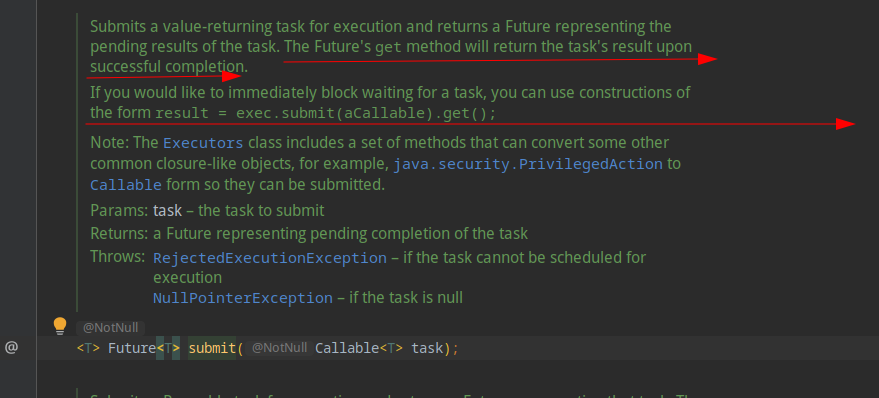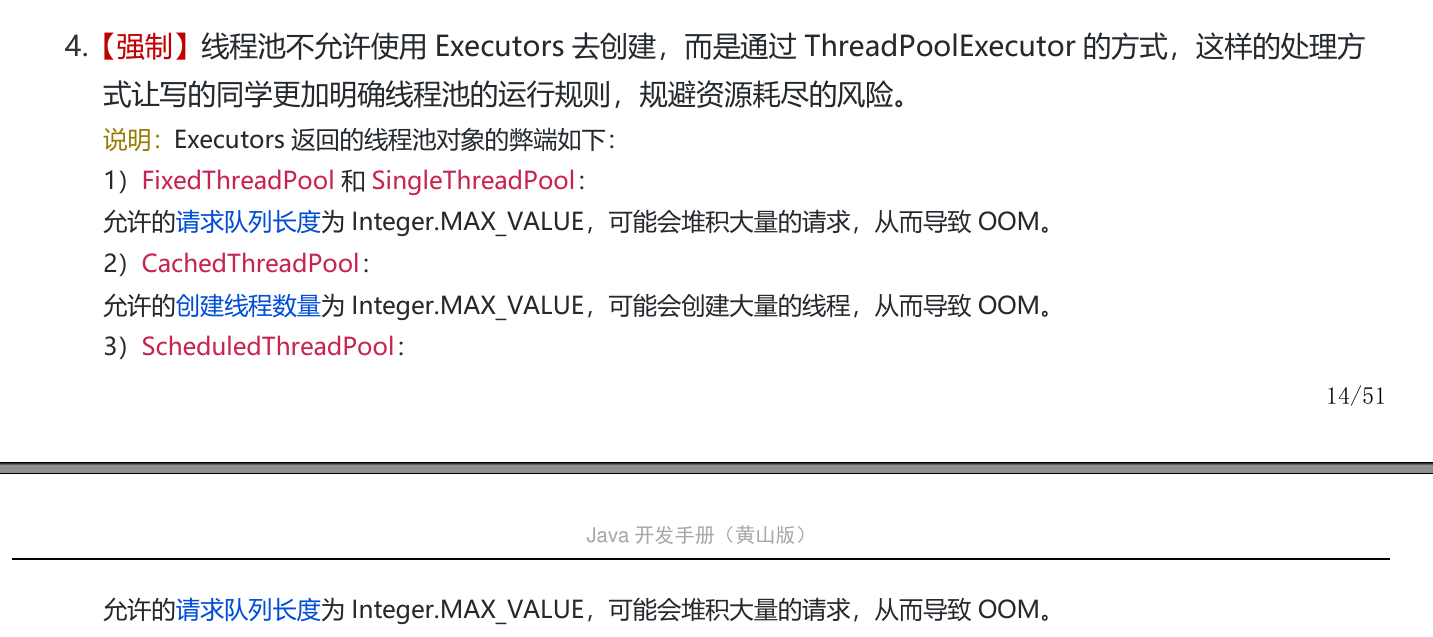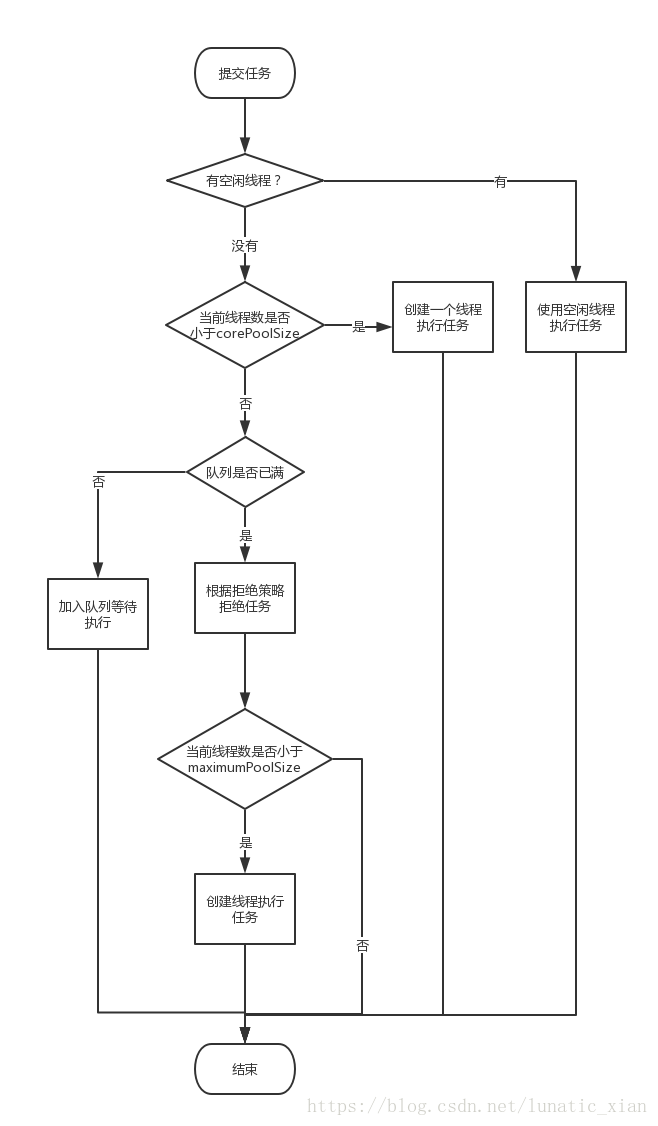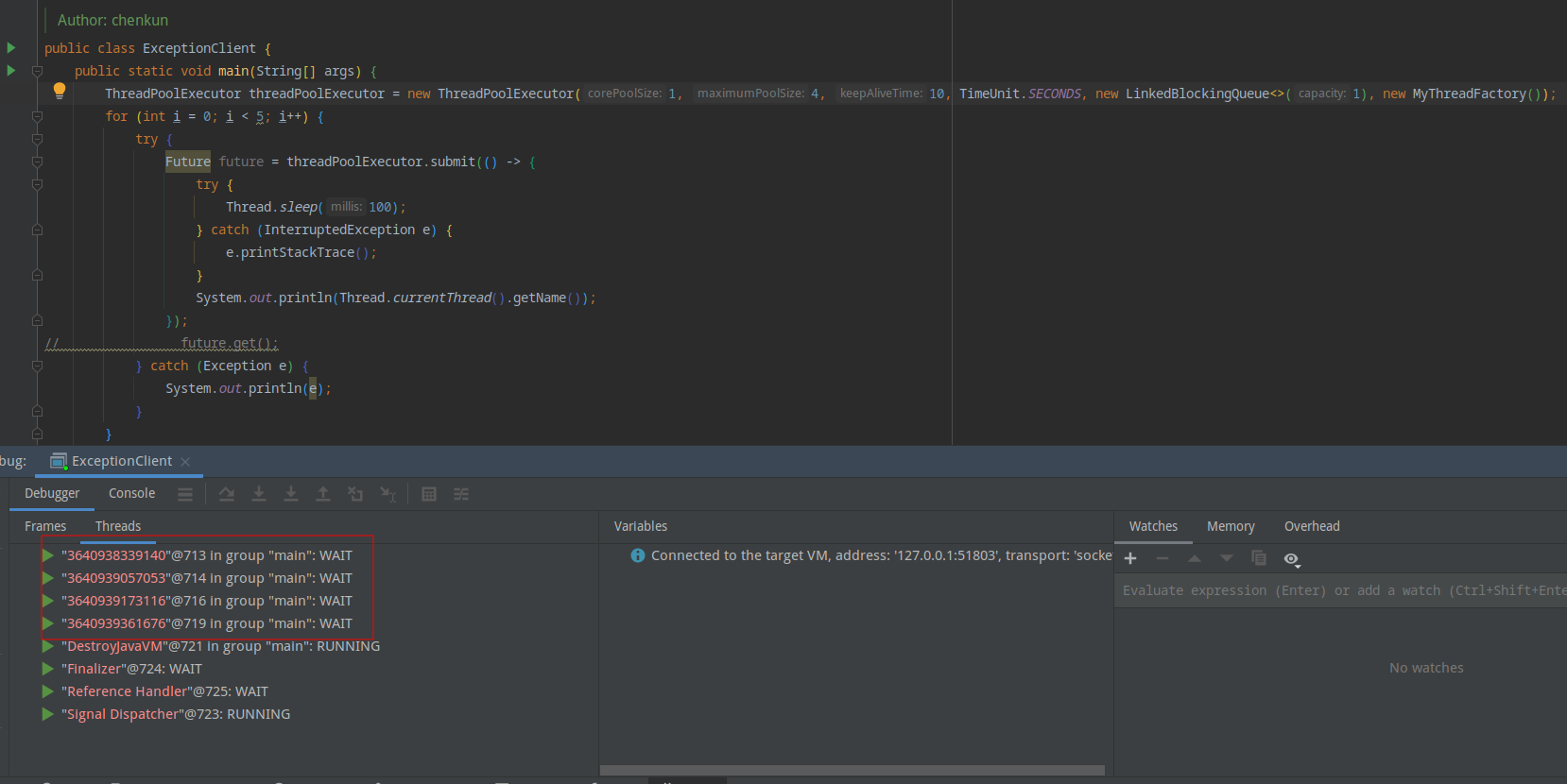线程池总结
线程池
前言:
线程池使用submit提交任务若遇到异常,线程不会直接抛出异常,在开发中要注意处理异常情况
1、先上测试代码
public static void main(String[] args) throws InterruptedException {
ExecutorService executorService = Executors.newFixedThreadPool(3);
executorService.submit(() -> {
System.out.println(Thread.currentThread().getName());
});
executorService.submit(() -> {
int a = 3/0;
System.out.println(Thread.currentThread().getName());
});
Thread.sleep(2000000);
}
测试结果:

测试发现异常并未抛出,如果不知道这个知识点线上遇到问题就不好排查,我因为在测试环境使用executorService.submit,submit方法提交后就没管了,结果在submit有异常,一直没往这里想,搞了俩小时才定位到。
2、 源码解析
/**
* Submits a Runnable task for execution and returns a Future
* representing that task. The Future's {@code get} method will
* return {@code null} upon <em>successful</em> completion.
*
* @param task the task to submit
* @return a Future representing pending completion of the task
* @throws RejectedExecutionException if the task cannot be
* scheduled for execution
* @throws NullPointerException if the task is null
*/
Future<?> submit(Runnable task);
注释中有说明,
submit方法执行成功时其返回的Future.get()应该是空;- 当传入的task为
null会直接在主进程抛出NPE,异常后调用它的进程后续代码就不会执行了;
2.1 修改测试代码继续测试
修改代码,在后面调用Future.get()看看
public static void main(String[] args) throws InterruptedException, ExecutionException {
ExecutorService executorService = Executors.newFixedThreadPool(3);
Future<?> future1 = executorService.submit(() -> {
System.out.println(Thread.currentThread().getName() + "正常线程");
});
Future<?> future2 = executorService.submit(() -> {
int a = 3 / 0;
System.out.println(Thread.currentThread().getName() + "异常线程");
});
// Runnable runnable = null;
// Future<?> future3 = executorService.submit(runnable);
Object o = future1.get();
System.out.println(o);
Object o1 = future2.get();
System.out.println(o1);
}

可以看到第一次执行成功的任务返回得到的是null,第二次抛出了异常,所以调用submit是要注意,此方法是带返回值的,和execute有区别,execute是没有返回值。
再看看为什么调用java.util.concurrent.Future#get()抛出异常,在以下源码注释写的很清楚了,当任务本身抛出异常,则调用get也会抛出一个ExecutionException

如果仅仅是为了能够抛出异常,直接使用execute即可,那么submit的Future有什么作用呢?
有时我们执行多线程任务时,希望得到返回结果,而直接提交Runnable类型的任务话,是没有返回值的,java提供了另一个接口叫做Callable,它可以执行一个带返回值的任务
2.2 测试带返回值的多线程任务
public static void main(String[] args) throws ExecutionException, InterruptedException {
ExecutorService executorService = Executors.newFixedThreadPool(2);
//lambda写法,此处传入的是一个Caller匿名实现类
String s = executorService.submit(() -> "ok hello").get();
System.out.println(s);
}

可以看到调用get方法获取到了caller接口实现类中的返回值

java.util.concurrent.ExecutorService#submit(java.util.concurrent.Callable<T>)源码

3、线程池的总结
3.1 不建议使用官方工具类直接创建
Executors工具类实际上只是对ThreadPoolExecutor进行了简单的封装,所以还是有必要对ThreadPoolExecutor进行学习

3.2 java.util.concurrent.ThreadPoolExecutor
3.2.1 构造方法

表面上看有4个,实际上就一个在干活,最终都调用的是下面这个,无非就是传递不同的构造参数,这里点开java.util.concurrent.Executors#newFixedThreadPool(int)看一下就知道了

构造参数说明:
corePoolSize:初始化时给该池子的线程数,当任务来了以后先初始化corePoolSize个线程放在池子(new ThreadPoolExecutor的时候还没有创建,是提交任务后才会初始化);
maximumPoolSize:当任务队列过多时最大能扩展的线程数;
keepAliveTime:当任务执行完了以后,空闲线程最大能空闲的时间,超过该时间则回收。比如corePoolSize为2,maximumPoolSize为4,BlockingQueue队列为2个长度,此时来了10个任务,则前2个任务交给corePoolSize 那两个线程来执行,3、4任务缓存在BlockingQueue队列中,第5个任务到来的时候,就要再起一个线程,第6个任务来了再起一个线程,此时总线程数已经达到了maximumPoolSize,有新任务来了也不能再起新的线程了(后面的7、8、9、10 任务请求再来的话就要根据设置的RejectedExecutionHandler策略来处理,此处先不考虑),当任务执行完后,新启动的两个线程也就空闲下来,这时就开始计时,空闲时间达到了keepAliveTime则把线程回收了,这是就是剩下corePoolSize个线程存活了。
缓冲队列参考:https://blog.csdn.net/ican87/article/details/80874933
workQueue:缓存的队列,有多重实现队列。实现1:ArrayBlockingQueue,有界队列,可以限制缓存队列的大小;实现二:LinkedBlockingQueue,无界队列,能最多缓存Integer.MAX_VALUE个(当然也可以在构造函数中指定固定数量的缓存队列),理论上可以缓存一直到内存耗尽,使用该队列后则maximumPoolSize就失效了;实现三:SynchronousQueue,直接提交策略表示线程池不对任务进行缓存。新进任务直接提交给线程池,当线程池中没有空闲线程时,创建一个新的线程处理此任务。这种策略需要线程池具有无限增长的可能性。
handler:任务过多(缓存队列已满,并且已扩展到maximumPoolSize个线程,后续再来新的任务就会触发)触发拒绝策略。ThreadPoolExecutor内置了多中静态内部类,对应各种拒绝策略。
(1)AbortPolicy 拒绝策略:抛出运行时异常RejectedExecutionException。 这种策略丢弃任务,并抛出异常。(jdk默认策略) (2)DiscardPolicy 拒绝策略:不能执行的任务将被丢弃。 这种策略什么都没做。 (3)DiscardOldestPolicy 拒绝策略:如果执行程序尚未关闭,则位于工作队列头部的任务将被删除,然后重试执行程序。

3.2.2 实验验证ThreadPoolExecutor各个参数的作用
3.2.2.1 第一次测试
自定义线程工厂,线程名随便起,我这里直接用时间戳
public class MyThreadFactory implements ThreadFactory {
@Override
public Thread newThread(Runnable r) {
Thread t = new Thread(null, r, "xxxx" + System.nanoTime());
return t;
}
}
第一次测试参数:
| 参数 | 参数值 |
|---|---|
| corePoolSize | 1 |
| maximumPoolSize | 4 |
| keepAliveTime | 100秒 |
| workQueue | new LinkedBlockingQueue<>(1) |
| threadFactory | 自定义工厂MyThreadFactory |
| handler | new ThreadPoolExecutor.AbortPolicy() |
public static void main(String[] args) throws InterruptedException {
ThreadPoolExecutor threadPoolExecutor = new ThreadPoolExecutor(1, 4, 100L, TimeUnit.SECONDS, new LinkedBlockingQueue<>(1), new MyThreadFactory(), new ThreadPoolExecutor.AbortPolicy());
//为了方便描述把此任务叫做A任务,以下分别为B\C\D
threadPoolExecutor.execute(() -> {
System.out.println(Thread.currentThread().getName()+ "=============AAAAAAAAAAAAaa");
try {
Thread.sleep(1001);
} catch (InterruptedException e) {
e.printStackTrace();
}
});
threadPoolExecutor.execute(() -> {
System.out.println(Thread.currentThread().getName() + "===========BBBBBBBBBB");
try {
Thread.sleep(1010);
} catch (InterruptedException e) {
e.printStackTrace();
}
});
threadPoolExecutor.execute(() -> {
System.out.println(Thread.currentThread().getName() + "===========CCCCCCCC");
try {
Thread.sleep(1001);
} catch (InterruptedException e) {
e.printStackTrace();
}
});
threadPoolExecutor.execute(() -> {
System.out.println(Thread.currentThread().getName() + "=========DDDDD");
try {
Thread.sleep(1001);
} catch (InterruptedException e) {
e.printStackTrace();
}
});
}
测试结果
xxxxxxx30832344860303=============AAAAAAAAAAAAaa
xxxxxxx30832345605562===========CCCCCCCC
xxxxxxx30832345942575=========DDDDD
xxxxxxx30832344860303===========BBBBBBBBBB
可以看到一共启动了3个线程,线程执行过程分析:
- 提交A任务,先初始化
corePoolSize个线程,并且分配一个线程执行A - 此时再提交B任务,因为
corePoolSize只有一个,所以需要给他缓存到队列,LinkedBlockingQueue设置的1,刚好可以缓存一个任务,B被缓存,先不执行 - 再提交C,此时发现
corePoolSize初始化的线程用完了,LinkedBlockingQueue也用完了,而maximumPoolSize为4,还可以启动3个线程,所以在给C分配一个线程,运行任务 - 再提交D,和第三步一样,在启动一个线程,此时就已经达到
maximumPoolSize个线程 - 空闲时间设置的100秒,意思是除了
corePoolSize初始化的那个线程之外的另3个线程,在执行完自己的任务后,可以再等100秒,如果100秒内没有新的任务申请使用线程,那么就会被回收
根据以上分析可以测试结果完全合理,运行过程为A-C-D-B,当B因为被放进了缓存队列,只有当其他线程执行完以后,有空闲的线程B才会有机会运行,所以它在最后执行,
注意:
以上我们上有4个任务,但是最终启动的线程只有3个,因为有一个被放进缓存队列
3.2.2.2 第二次测试
在第一次测试基础上在加2个任务,测试拒绝策略,为什么加一个不行?自行思考一下
public static void main(String[] args) throws InterruptedException {
ThreadPoolExecutor threadPoolExecutor = new ThreadPoolExecutor(1, 4, 100L, TimeUnit.SECONDS, new LinkedBlockingQueue<>(1), new MyThreadFactory(), new ThreadPoolExecutor.AbortPolicy());
threadPoolExecutor.execute(() -> {
System.out.println(Thread.currentThread().getName()+ "=============AAAAAAAAAAAAaa");
try {
Thread.sleep(1001);
} catch (InterruptedException e) {
e.printStackTrace();
}
});
threadPoolExecutor.execute(() -> {
System.out.println(Thread.currentThread().getName() + "===========BBBBBBBBBB");
try {
Thread.sleep(1010);
} catch (InterruptedException e) {
e.printStackTrace();
}
});
threadPoolExecutor.execute(() -> {
System.out.println(Thread.currentThread().getName() + "===========CCCCCCCC");
try {
Thread.sleep(1001);
} catch (InterruptedException e) {
e.printStackTrace();
}
});
threadPoolExecutor.execute(() -> {
System.out.println(Thread.currentThread().getName() + "=========DDDDD");
try {
Thread.sleep(1001);
} catch (InterruptedException e) {
e.printStackTrace();
}
});
threadPoolExecutor.execute(() -> {
System.out.println(Thread.currentThread().getName() + "=========EEEEEE");
try {
Thread.sleep(1001);
} catch (InterruptedException e) {
e.printStackTrace();
}
});
threadPoolExecutor.execute(() -> {
System.out.println(Thread.currentThread().getName() + "=========ffff");
try {
Thread.sleep(1001);
} catch (InterruptedException e) {
e.printStackTrace();
}
});
}
测试结果:
xxxxxxx31891613408362=============AAAAAAAAAAAAaa
xxxxxxx31891614159432===========CCCCCCCC
xxxxxxx31891614545186=========DDDDD
xxxxxxx31891614917120=========EEEEEE
Exception in thread "main" java.util.concurrent.RejectedExecutionException: Task com.chen.base.thread.ThreadFactoryClient$$Lambda$6/1828972342@568db2f2 rejected from java.util.concurrent.ThreadPoolExecutor@378bf509[Running, pool size = 4, active threads = 4, queued tasks = 1, completed tasks = 0]
at java.util.concurrent.ThreadPoolExecutor$AbortPolicy.rejectedExecution(ThreadPoolExecutor.java:2063)
at java.util.concurrent.ThreadPoolExecutor.reject(ThreadPoolExecutor.java:830)
at java.util.concurrent.ThreadPoolExecutor.execute(ThreadPoolExecutor.java:1379)
at com.chen.base.thread.ThreadFactoryClient.main(ThreadFactoryClient.java:56)
xxxxxxx31891613408362===========BBBBBBBBBB
可以看到触发了设置的拒绝策略,任务超出时直接抛出异常
3.2.3 几种线程池的实现
//缓存池,初始化0个线程,使用SynchronousQueue队列每次来了新任务马上起一个新的线程,而不是缓存下来,最大可以起Integer.MAX_VALUE个线程(内存够用前提下)
public static ExecutorService newCachedThreadPool() {
return new ThreadPoolExecutor(0, Integer.MAX_VALUE,
60L, TimeUnit.SECONDS,
new SynchronousQueue<Runnable>());
}
//单个线程池,相当于把固定池的线程数设置成1个 public static ExecutorService newSingleThreadExecutor() {
return new FinalizableDelegatedExecutorService
(new ThreadPoolExecutor(1, 1,
0L, TimeUnit.MILLISECONDS,
new LinkedBlockingQueue<Runnable>()));
}
//固定线程数的线程池,注意他的初始化线程数和最大线程数是一样,一旦任务超过线程数就开始无限缓存,等线程处理完其他任务后再从无界队列中取任务来处理
public static ExecutorService newFixedThreadPool(int nThreads) {
return new ThreadPoolExecutor(nThreads, nThreads,
0L, TimeUnit.MILLISECONDS,
new LinkedBlockingQueue<Runnable>());
}
3.2.3 线程池中任务执行流程

3.3 线程池中的异常处理
线程池中提交任务的两种方法:submit、execute,submit方法的参数可以是Runnable、Caller,execute的参数类型只有Runnable,submit提交的方法可以获取返回值,要想获取返回值需要传递Caller类型
//java.util.concurrent.ThreadPoolExecutor#execute
public void execute(Runnable command) {
if (command == null)
throw new NullPointerException();
/*
* Proceed in 3 steps:
*
* 1. If fewer than corePoolSize threads are running, try to
* start a new thread with the given command as its first
* task. The call to addWorker atomically checks runState and
* workerCount, and so prevents false alarms that would add
* threads when it shouldn't, by returning false.
*
* 2. If a task can be successfully queued, then we still need
* to double-check whether we should have added a thread
* (because existing ones died since last checking) or that
* the pool shut down since entry into this method. So we
* recheck state and if necessary roll back the enqueuing if
* stopped, or start a new thread if there are none.
*
* 3. If we cannot queue task, then we try to add a new
* thread. If it fails, we know we are shut down or saturated
* and so reject the task.
*/
int c = ctl.get();
if (workerCountOf(c) < corePoolSize) {
if (addWorker(command, true))
return;
c = ctl.get();
}
if (isRunning(c) && workQueue.offer(command)) {
int recheck = ctl.get();
if (! isRunning(recheck) && remove(command))
reject(command);
else if (workerCountOf(recheck) == 0)
addWorker(null, false);
}
else if (!addWorker(command, false))
reject(command);
}
//继承自AbstractExecutorService
//java.util.concurrent.AbstractExecutorService#submit(java.util.concurrent.Callable<T>)
public <T> Future<T> submit(Callable<T> task) {
if (task == null) throw new NullPointerException();
RunnableFuture<T> ftask = newTaskFor(task);
execute(ftask);
return ftask;
}
//继承自AbstractExecutorService
//java.util.concurrent.AbstractExecutorService#submit(java.lang.Runnable)
public Future<?> submit(Runnable task) {
if (task == null) throw new NullPointerException();
RunnableFuture<Void> ftask = newTaskFor(task, null);
execute(ftask);
return ftask;
}
3.2.1 使用execute时的异常处理
使用execute提交有异常会正常的抛出,当然也可以自定义异常处理器
public class MyThreadFactory implements ThreadFactory {
@Override
public Thread newThread(Runnable r) {
Thread thread = new Thread(null, r, "xxxxxxx" + System.nanoTime());
thread.setUncaughtExceptionHandler((t, e) -> {
System.out.println("enter into uncaughtException");
System.out.println("异常信息:"+ e.getMessage());
});
return thread;
}
}
public static void main(String[] args) {
ThreadPoolExecutor threadPoolExecutor = new ThreadPoolExecutor(1, 11, 100L, TimeUnit.SECONDS, new LinkedBlockingQueue<>(2), new MyThreadFactory());
try {
threadPoolExecutor.execute(() -> {
System.out.println("enter into submit");
throw new RuntimeException("我是一个异常信息。。。");
});
} catch (Exception e) {
System.out.println("eee");
System.out.println(e);
}
}
3.2.2 使用submit时的异常处理
submit会返回一个future,需要主动调用这个future的get方法才会触发异常,如果正常执行传递的runnable类型,则返回null,如果是caller类型参数,会返回相应的值
public class MyThreadFactory implements ThreadFactory {
@Override
public Thread newThread(Runnable r) {
Thread thread = new Thread(null, r, "xxxxxxx" + System.nanoTime());
thread.setUncaughtExceptionHandler((t, e) -> {
System.out.println("enter into uncaughtException");
System.out.println("异常信息:"+ e.getMessage());
});
return thread;
}
}
public static void main(String[] args) {
ThreadPoolExecutor threadPoolExecutor = new ThreadPoolExecutor(1, 11, 100L, TimeUnit.SECONDS, new LinkedBlockingQueue<>(2), new MyThreadFactory());
try {
Future future= threadPoolExecutor.submit(() -> {
System.out.println("enter into submit");
throw new RuntimeException("我是一个异常信息。。。");
});
future.get();
} catch (Exception e) {
System.out.println("eee");
System.out.println(e);
}
}
3.4 补充说明
关于ThreadPoolExecutor的构造方法中的keepAliveTime说明
[在前面有说明](#3.2.1 构造方法),在举例罗嗦一边,代码如下,第一个任务进来,直接启动一个线程,也就是corePoolSize设置的那个线程,第二个任务进来直接缓存到LinkedBlockingQueue中,第三个线程进来,发现LinkedBlockingQueue已经满了(因为示例代码缓存长度是1)直接再启动一个线程,这个占用的是maxmumPoolSize设置的线程,第4个、第5个任务进来和第三个一样,再各自启动一个线程,此时池中一共有4个线程了,再有任务进来就会触发拒绝策略,此处不做描述了。当池子中的数量超过了corePoolSize设置的数量是,这个keepAliveTime参数就起作用了,假如任务都执行完了,4个线程都是空闲(idle),则先空闲满keepAliveTime这么长时间的线程就会被回收,最后剩下corePoolSize个时不再回收,这corePoolSize个线程一直缓存在池子中。
new ThreadPoolExecutor(1, 4, 200, TimeUnit.SECONDS, new LinkedBlockingQueue<>(1), new MyThreadFactory());
测试代码如下,我设置keepAliveTime是10s,
public static void main(String[] args) {
ThreadPoolExecutor threadPoolExecutor = new ThreadPoolExecutor(1, 4, 10, TimeUnit.SECONDS, new LinkedBlockingQueue<>(1), new MyThreadFactory());
for (int i = 0; i < 5; i++) {
try {
Future future = threadPoolExecutor.submit(() -> {
try {
Thread.sleep(100);
} catch (InterruptedException e) {
e.printStackTrace();
}
System.out.println(Thread.currentThread().getName());
});
//一定不要打开future.get(),这个方法会触发同步操作,导致永远只有一个线程在工作
// future.get();
} catch (Exception e) {
System.out.println(e);
}
}
测试结果,发现刚开始有4个线程,

过了10s后,发现只有一个了,符合我们的预期

java.util.concurrent.Future#get()有说明,get是会一直等到此线程结束
